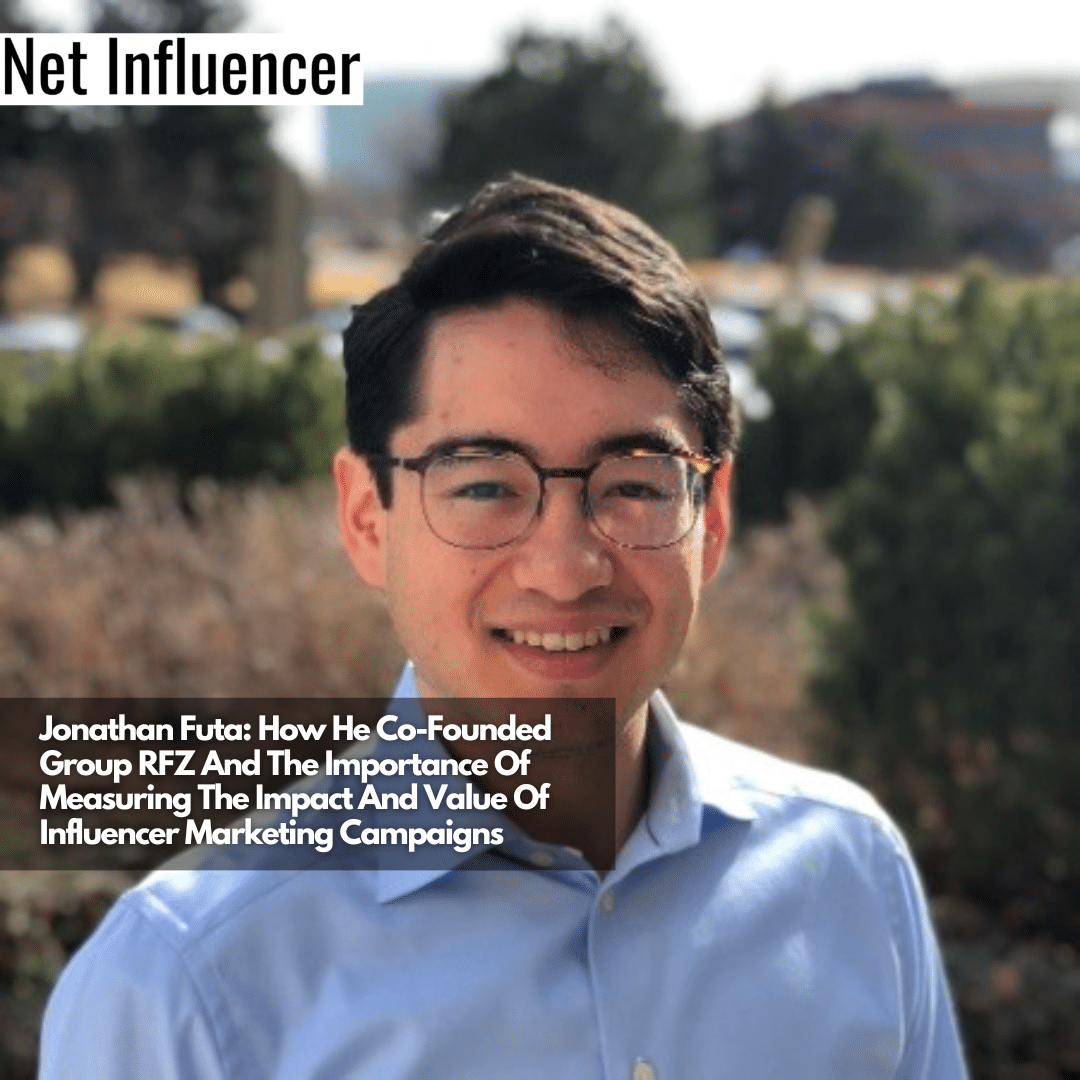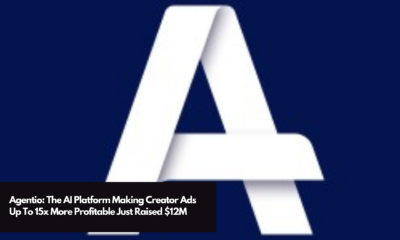Technology
Jonathan Futa: How He Co-Founded Group RFZ And The Importance Of Measuring The Impact And Value Of Influencer Marketing Campaigns
Jonathan Futa co-founded Group RFZ after seeing how marketers lack the basic insights to capture the ROI of influencer marketing. Fast forward to 2023, and Group RFZ has been helping marketers track the progress and success of their influencer marketing campaigns using brand lift studies.
Get to know more about Jonathan Futa, his journey in co-founding Group RFZ, and how this company is revolutionizing the influencer marketing industry.
Jonathan Futa co-founded Group RFZ after seeing how marketers lack the basic insights to capture the ROI of influencer marketing. Fast forward to 2023, and Group RFZ has been helping marketers track the progress and success of their influencer marketing campaigns using brand lift studies.
Get to know more about Jonathan Futa, his journey in co-founding Group RFZ, and how this company is revolutionizing the influencer marketing industry.
Who is Jonathan Futa?
Jonathan Futa is a co-founder at Group RFZ. He has been creating solutions for clients’ marketing research programs for years but was struck by the mismatch between the available passive metrics marketers relied on and the emotional connection they ultimately sought to create. Group RFZ was founded to address this mismatch.

Can you tell us about the journey and inspiration behind the establishment of Group RFZ?
Sure. We started the company in 2018 with a methodology that was born out of political work. I had previously been involved with strategic research for political campaigns. Our clients were looking for ways to conduct political research among very small, niche groups that were very difficult to engage through traditional methods such as panel surveys. To overcome these limitations, I started applying a brand lift study methodology that involved recruiting participants over social media and surveying them on topics such as favorability and intent.
When we started Group RFZ, our team saw a huge opportunity to transition this methodology to marketers and agencies contending with similar measurement challenges. That led us to form Group RFZ and today we’re focused specifically on influencer marketing measurement, conducting brand lift studies to help clients assess the performance of their campaigns and programs.
How do brand lift studies provide a clearer picture of the value and effectiveness of influencer campaigns compared to traditional metrics like reach and engagement?
The fact is that digital and performance metrics, such as reach and engagement, only provide a piece of the story. A high engagement rate doesn’t necessarily mean a post was impactful and resonated with people in the intended way.
I’ll give you an example. Recently, we’ve seen more influencers purposefully put a typo in the text of their videos. This strategy succeeds in garnering tons of comments from people calling out the error, which results in an extremely high engagement rate. However, that doesn’t necessarily mean the post achieved its goal. In fact, it probably didn’t. At the end of the day, the goal of every campaign is to convince people, change their minds, and get the message across – not only to be seen. That’s why it’s important to contextualize engagement and measure your success against metrics such as purchase intent and favorability that are more telling.
At Group RFZ, we dig one level deeper, with our brand lift studies revealing the actual impact of that content on viewers, followers, and people who engaged with it. These types of metrics show you whether or not your campaign succeeded in achieving the goals that actually matter.
What are some key metrics or indicators that you believe should be considered when evaluating the success of an influencer campaign?
We look at the top of the funnel all the way down to the mid-funnel, such as favorability and intent. These are extremely important metrics that we evaluate with every project we do.
It’s common to see industry white papers proclaim that recall is the number one metric for brands and, while it is important, it isn’t the only critical measurement. Recalling doesn’t always mean the audience likes the product and is more inclined to purchase it.
In our approach, we always go further by looking at purchase intent, likelihood to consider, favorability, brand love, and, most importantly, brand attributes.
Can you provide an example of a brand lift study that Group RFZ conducted that demonstrated the impact of influencer campaigns?
Group RFZ has worked across a broad range of industries, from financial services to consumer packaged goods. One program we recently worked on was for Waze in the United Kingdom. Twelve creators were commissioned to post Reels and Stories on Instagram to convey in a fun, personal and irreverent way that Waze is the go-to app when it comes to making daily commutes bearable.
It was important to Waze to demonstrate the impact the program had on awareness, favorability, specific attributes and likelihood to use the app. Our brand lift solution was used to uncover how the program made UK drivers think and feel about Waze, and how it shifted their likelihood to use the app going forward. In addition to campaign-level insights, Waze wanted to understand how each portion of the campaign worked – the organic posts that the influencers made, as well as the paid content that was amplified to an interest-based targeting audience
Measurement was one of the most compelling and telling pieces of the program. We designed a brand lift study that evaluated the effectiveness of influencer’s content among three groups: exposed organic, exposed amplified and control. The survey involved asking questions around brand awareness, consideration and purchase intent. We found that the program generated significant lift across both organic and paid, with favorability, likelihood to use and purchase intent all increasing by wide margins. For instance, there was a +12 lift in aided awareness and a 5x increase in very favorable ratings of Waze among the amplified group, and there was also an impressive 15-point lift for likelihood to use among the organic group.
Could you share some notable campaign content gaffes you have encountered while measuring influencer campaigns?
Every campaign is different, and marketers will always seek to understand why one worked and the others didn’t. In my day-to-day, the most common pitfall I see is the brand or product not being mentioned or highlighted enough by the influencers tapped for campaigns.
It’s common knowledge that the most successful influencer marketing campaigns are the ones that appear authentic. Because of that, brands often want their influencers to talk about their products in the most authentic way and downplay that it’s an ad, despite the fact that they’re required to include an ad hashtag or otherwise disclose that it’s a paid partnership.
Influencers often try to overcome these barriers by only subtly including the product in their content and not really highlighting it in their posting. However, not mentioning the brand or its products backfires because then the influencer’s effort fails to improve their audience’s perception of the brand.
You might still see an increase in engagement because people love the influencer or because the influencer used the product, but these instances don’t often result in improvements in perceptions towards the brand or its products, which is what a brand lift study will reveal.
I tell clients that consumers are savvy and will always know it’s an ad. You may as well accept that and push it further towards being an ad that you’re comfortable with to ensure you’re getting across those messages.
What are the main challenges brands face when it comes to influencer compensation, and how is the industry adapting to address these issues?
Right now, everyone is primarily still approaching compensation in the typical way that influencer marketing sprung and started, which is direct payments for individual campaigns or longer-term contracts where influencers are contracted, say for one year, and are paid a certain amount every time they post.
Another common strategy is to give influencers a percentage of sales. For anything purchased through their link or coupon code, the influencer gets a certain amount or percentage of that sale.
While these approaches are still effective and will not go away anytime soon, we’ll also see more creative options start to take hold. This is especially true as influencers are becoming more and more powerful as they’re the ones introducing consumers to brands.
In the future, I anticipate we’ll see more scenarios where creators are working to monetize their following themselves and brands will have to adapt to continue to engage with them. If you look at the Kardashians, their source of income and wealth is their own brand that they have created. After accumulating an audience, they created their own brands and monetized their name that way.
I expect to see more creators taking the same route in the future. If a brand wants to get ahead of that or at least capture that early, they should be part of it rather than adversarial to it. Brands should be more open to co-creation, not only in terms of making content with their influencers, but also in terms of teaming with them on product development.
This strategy usually involves bringing influencers and creators into the company and offering them a revenue share on a new scale or other types of actual buy-in.
Are there any emerging trends or technologies that you see shaping the future of influencer marketing and measurement?
The biggest ones unfolding right now are related to data privacy and regulation. These regulations are already being implemented and we’ll be hearing and seeing much more on these topics over the next several years.
Data privacy is a big issue right now for the entire tech sector, whether it’s marketing, sales, or anyone who is tangentially related to the tech space, and influencers are at the heart of it. When people talk about data privacy, one of the main offenders in the general public’s mind is social media platforms like Facebook. TikTok is currently the most dominant player, but it is facing bans in some countries and states. TikTok collects a vast amount of data on people and uses that for a number of purposes, so it has to find ways to deal with data regulations and data privacy. This is a major trend that will significantly disrupt the influencer marketing industry.
Overall, though, influencer marketing is actually in a good position to contend with these regulations because the industry doesn’t rely on third-party data or cookies. Instead, the influencers bring their own audiences into the fold.
The next part is the platforms and how platforms will change, whether it’s via data regulation and data privacy concerns or just simply to stay in front and stay relevant as new platforms come into play. As the industry changes and more players enter the mix, existing platforms will have to cater more to creators rather than just a typical person who’s posting on Instagram to show pictures.
What advice would you give to marketers who are just beginning to incorporate influencer marketing into their overall strategies?
My advice is for them is to just start doing it and grow their programs slowly and steadily as they learn from previous ones. Also, integrate it into your larger programs and don’t merely leave it as a side project. I firmly believe in the power of the influencer channel and canvouch for howeffective and impactful a strategy it can be.





![How Gen Alpha Feels About Influencer Marketing [REPORT]](https://www.netinfluencer.com/wp-content/uploads/2024/11/How-Gen-Alpha-Feels-About-Influencer-Marketing-REPORT-400x240.png)
![How Gen Alpha Feels About Influencer Marketing [REPORT]](https://www.netinfluencer.com/wp-content/uploads/2024/11/How-Gen-Alpha-Feels-About-Influencer-Marketing-REPORT-100x100.png)
![Gen Z More Likely To Find Longer Videos Engaging Than Millennials [REPORT]](https://www.netinfluencer.com/wp-content/uploads/2024/10/Gen-Z-More-Likely-To-Find-Longer-Videos-Engaging-Than-Millennials-REPORT-400x240.png)
![Gen Z More Likely To Find Longer Videos Engaging Than Millennials [REPORT]](https://www.netinfluencer.com/wp-content/uploads/2024/10/Gen-Z-More-Likely-To-Find-Longer-Videos-Engaging-Than-Millennials-REPORT-100x100.png)










